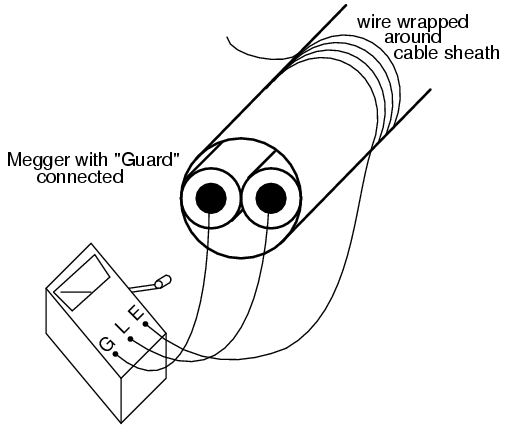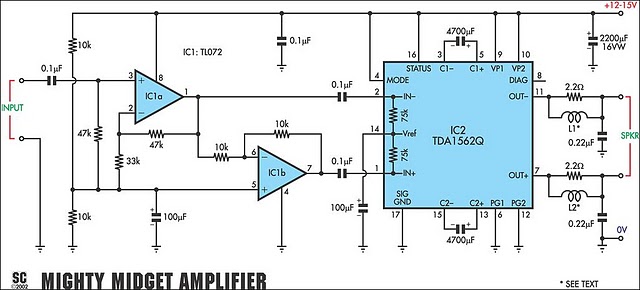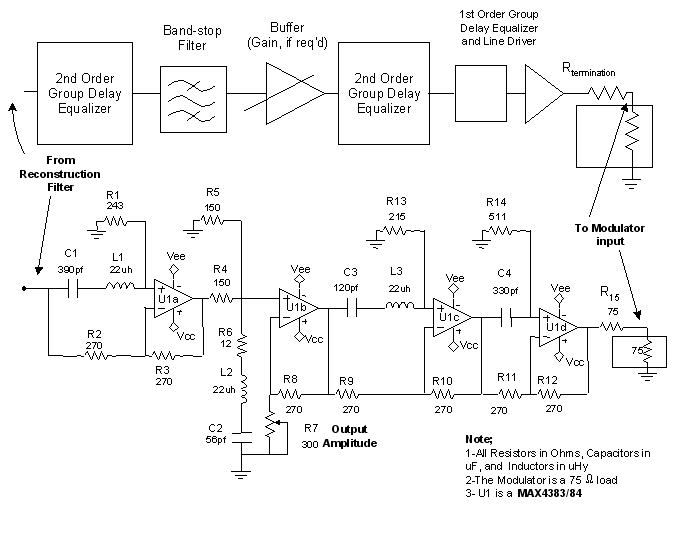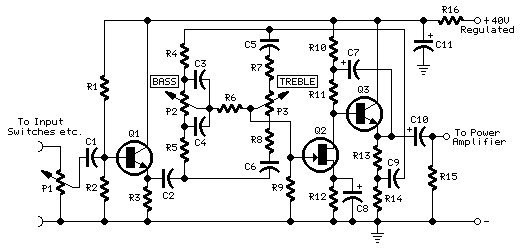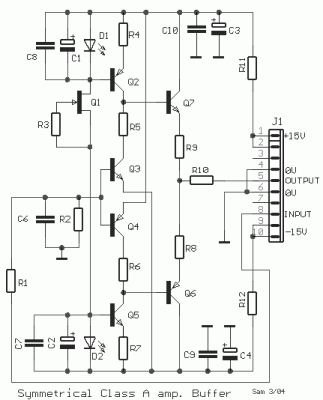
Class B audio amplifier Analog Integrated Circuits
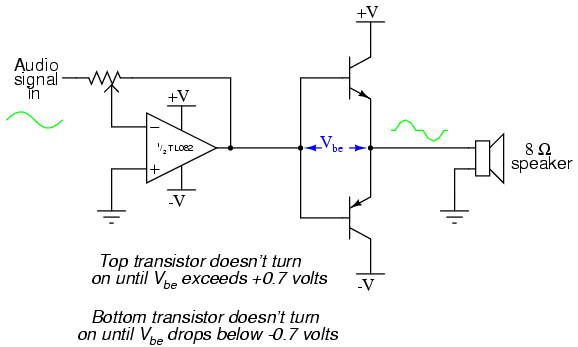
This project is an audio amplifier designed to amplify output signals from small radios, tape players, CD players, or other audio signal sources. For stereo operation, two identical amplifiers must be constructed—one for the left channel and another for the right channel. The input signal for amplification can be obtained by connecting it to the output of a radio or any audio device. This amplifier circuit is also effective at amplifying "line-level" audio signals from high-quality modular stereo components. It delivers a significant amount of sound power when played through a large speaker and can operate without heat sinks on the transistors, although experimentation is recommended before deciding against them, as power dissipation varies with the type of speaker used. The primary goal of any amplifier circuit is to reproduce the input waveform as accurately as possible. However, perfect reproduction is unattainable, and any discrepancies between the output and input waveforms result in distortion. In audio amplifiers, distortion can introduce unpleasant tones into the sound. Various configurations of audio amplifier circuitry exist, each with unique advantages and disadvantages. This specific circuit is classified as a "class B" push-pull circuit. Most audio power amplifiers utilize a class B configuration, wherein one transistor supplies power to the load during one-half of the waveform cycle (the push phase), while a second transistor provides power during the other half (the pull phase). In this arrangement, neither transistor is "on" for the entire cycle, allowing each to rest and cool during the waveform cycle. This design results in a power-efficient amplifier circuit but can lead to a specific form of nonlinearity known as "crossover distortion." If the transition between the two transistors is not perfectly synchronized, the amplifier's output waveform may deviate from a pure sine wave. This distortion occurs due to a delay in switching between the transistors, resulting in a "flattening" of the waveform at the crossover point between positive and negative half-cycles, known as crossover distortion. A common approach to mitigate crossover distortion involves biasing the transistors so their turn-on and turn-off points overlap, allowing both transistors to conduct simultaneously for a brief moment during the crossover period. This method is technically referred to as class AB amplification, as each transistor remains "on" for more than 50% of the complete waveform cycle. However, this increases the amplifier circuit's power consumption since both transistors conduct current that does not pass through the load, effectively shorting from one power supply rail to the other (from -V to +V). This not only wastes energy but also generates more heat in the transistors. As the temperature of the transistors rises, their characteristics change (such as the Vbe forward voltage drop and junction resistances), complicating proper biasing. In this experiment, the transistors operate in pure class B mode, meaning they do not conduct simultaneously. This approach conserves energy and minimizes heat dissipation but is susceptible to crossover distortion. The solution implemented in this circuit employs an operational amplifier (op-amp) with negative feedback to drive the transistors through the "dead" zone, thereby reducing the waveform "flattening" during crossover. The first op-amp in the schematic diagram functions as a buffer, which helps to minimize the loading on the input capacitors.
The audio amplifier circuit described operates using a class B push-pull configuration, which is favored for its efficiency in power amplification. Each transistor in the circuit is responsible for driving the load during alternate half-cycles of the input signal, preventing continuous conduction and thus reducing thermal stress. The design allows for a straightforward connection to various audio sources, facilitating versatility in application.
The operational amplifier included in the circuit serves a critical role in managing the transition between the two output transistors. By implementing negative feedback, it effectively minimizes the crossover distortion typically associated with class B amplifiers, enhancing overall sound quality. This is particularly important in audio applications where fidelity is paramount.
The circuit's layout should include appropriate biasing resistors to set the operating point of the transistors, ensuring that they remain in the desired mode of operation. The use of capacitors for coupling and decoupling signals is also essential to maintain signal integrity and prevent unwanted noise from affecting performance.
In practical terms, careful consideration must be given to the selection of transistors, as their characteristics directly influence the amplifier's performance. Additionally, the choice of power supply voltage will impact the output power and headroom available for the amplifier. Experimentation with different speaker loads and configurations can further optimize the amplifier's performance, tailoring it to specific audio applications.This project is an audio amplifier suitable for amplifying the output signal from a small radio, tape player, CD player, or any other source of audio signals. For stereo operation, two identical amplifiers must be built, one for the left channel and other for the right channel.
To obtain an input signal for this amplifier to amplify, just connect it to the output of a radio or other audio device like this: This amplifier circuit also works well in amplifying "line-level" audio signals from high-quality, modular stereo components. It provides a surprising amount of sound power when played through a large speaker, and may be run without heat sinks on the transistors (though you should experiment with it a bit before deciding to forego heat sinks, as the power dissipation varies according to the type of speaker used).
The goal of any amplifier circuit is to reproduce the input waveshape as accurately as possible. Perfect reproduction is impossible, of course, and any differences between the output and input waveshapes is known as distortion. In an audio amplifier, distortion may cause unpleasant tones to be superimposed on the true sound. There are many different configurations of audio amplifier circuitry, each with its own advantages and disadvantages.
This particular circuit is called a "class B, " push-pull circuit. Most audio "power" amplifiers use a class B configuration, where one transistor provides power to the load during one-half of the waveform cycle (it pushes) and a second transistor provides power to the load for the other half of the cycle (it pulls). In this scheme, neither transistor remains "on" for the entire cycle, giving each one a time to "rest" and cool during the waveform cycle.
This makes for a power-efficient amplifier circuit, but leads to a distinct type of nonlinearity known as "crossover distortion. " If the "hand-off" between the two transistors is not precisely synchronized, though, the amplifier`s output waveform may look something like this instead of a pure sine wave: Here, distortion results from the fact that there is a delay between the time one transistor turns off and the other transistor turns on.
This type of distortion, where the waveform "flattens" at the crossover point between positive and negative half-cycles, is called crossover distortion. One common method of mitigating crossover distortion is to bias the transistors so that their turn-on/turn-off points actually overlap, so that both transistors are in a state of conduction for a brief moment during the crossover period: This form of amplification is technically known as class AB rather than class B, because each transistor is "on" for more than 50% of the time during a complete waveform cycle.
The disadvantage to doing this, though, is increased power consumption of the amplifier circuit, because during the moments of time where both transistors are conducting, there is current conducted through the transistors that is not going through the load, but is merely being "shorted" from one power supply rail to the other (from -V to +V). Not only is this a waste of energy, but it dissipates more heat energy in the transistors. When transistors increase in temperature, their characteristics change (Vbe forward voltage drop, ², junction resistances, etc.
), making proper biasing difficult. In this experiment, the transistors operate in pure class B mode. That is, they are never conducting at the same time. This saves energy and decreases heat dissipation, but lends itself to crossover distortion. The solution taken in this circuit is to use an op-amp with negative feedback to quickly drive the transistors through the "dead" zone producing crossover distortion and reduce the amount of "flattening" of the waveform during crossover. The first (leftmost) op-amp shown in the schematic diagram is nothing more than a buffer. A buffer helps to reduce the loading of the input capac 🔗 External reference
The audio amplifier circuit described operates using a class B push-pull configuration, which is favored for its efficiency in power amplification. Each transistor in the circuit is responsible for driving the load during alternate half-cycles of the input signal, preventing continuous conduction and thus reducing thermal stress. The design allows for a straightforward connection to various audio sources, facilitating versatility in application.
The operational amplifier included in the circuit serves a critical role in managing the transition between the two output transistors. By implementing negative feedback, it effectively minimizes the crossover distortion typically associated with class B amplifiers, enhancing overall sound quality. This is particularly important in audio applications where fidelity is paramount.
The circuit's layout should include appropriate biasing resistors to set the operating point of the transistors, ensuring that they remain in the desired mode of operation. The use of capacitors for coupling and decoupling signals is also essential to maintain signal integrity and prevent unwanted noise from affecting performance.
In practical terms, careful consideration must be given to the selection of transistors, as their characteristics directly influence the amplifier's performance. Additionally, the choice of power supply voltage will impact the output power and headroom available for the amplifier. Experimentation with different speaker loads and configurations can further optimize the amplifier's performance, tailoring it to specific audio applications.This project is an audio amplifier suitable for amplifying the output signal from a small radio, tape player, CD player, or any other source of audio signals. For stereo operation, two identical amplifiers must be built, one for the left channel and other for the right channel.
To obtain an input signal for this amplifier to amplify, just connect it to the output of a radio or other audio device like this: This amplifier circuit also works well in amplifying "line-level" audio signals from high-quality, modular stereo components. It provides a surprising amount of sound power when played through a large speaker, and may be run without heat sinks on the transistors (though you should experiment with it a bit before deciding to forego heat sinks, as the power dissipation varies according to the type of speaker used).
The goal of any amplifier circuit is to reproduce the input waveshape as accurately as possible. Perfect reproduction is impossible, of course, and any differences between the output and input waveshapes is known as distortion. In an audio amplifier, distortion may cause unpleasant tones to be superimposed on the true sound. There are many different configurations of audio amplifier circuitry, each with its own advantages and disadvantages.
This particular circuit is called a "class B, " push-pull circuit. Most audio "power" amplifiers use a class B configuration, where one transistor provides power to the load during one-half of the waveform cycle (it pushes) and a second transistor provides power to the load for the other half of the cycle (it pulls). In this scheme, neither transistor remains "on" for the entire cycle, giving each one a time to "rest" and cool during the waveform cycle.
This makes for a power-efficient amplifier circuit, but leads to a distinct type of nonlinearity known as "crossover distortion. " If the "hand-off" between the two transistors is not precisely synchronized, though, the amplifier`s output waveform may look something like this instead of a pure sine wave: Here, distortion results from the fact that there is a delay between the time one transistor turns off and the other transistor turns on.
This type of distortion, where the waveform "flattens" at the crossover point between positive and negative half-cycles, is called crossover distortion. One common method of mitigating crossover distortion is to bias the transistors so that their turn-on/turn-off points actually overlap, so that both transistors are in a state of conduction for a brief moment during the crossover period: This form of amplification is technically known as class AB rather than class B, because each transistor is "on" for more than 50% of the time during a complete waveform cycle.
The disadvantage to doing this, though, is increased power consumption of the amplifier circuit, because during the moments of time where both transistors are conducting, there is current conducted through the transistors that is not going through the load, but is merely being "shorted" from one power supply rail to the other (from -V to +V). Not only is this a waste of energy, but it dissipates more heat energy in the transistors. When transistors increase in temperature, their characteristics change (Vbe forward voltage drop, ², junction resistances, etc.
), making proper biasing difficult. In this experiment, the transistors operate in pure class B mode. That is, they are never conducting at the same time. This saves energy and decreases heat dissipation, but lends itself to crossover distortion. The solution taken in this circuit is to use an op-amp with negative feedback to quickly drive the transistors through the "dead" zone producing crossover distortion and reduce the amount of "flattening" of the waveform during crossover. The first (leftmost) op-amp shown in the schematic diagram is nothing more than a buffer. A buffer helps to reduce the loading of the input capac 🔗 External reference
Warning: include(partials/cookie-banner.php): Failed to open stream: Permission denied in /var/www/html/nextgr/view-circuit.php on line 713
Warning: include(): Failed opening 'partials/cookie-banner.php' for inclusion (include_path='.:/usr/share/php') in /var/www/html/nextgr/view-circuit.php on line 713
